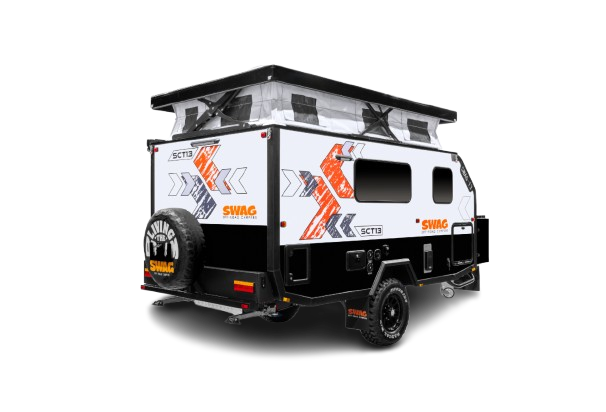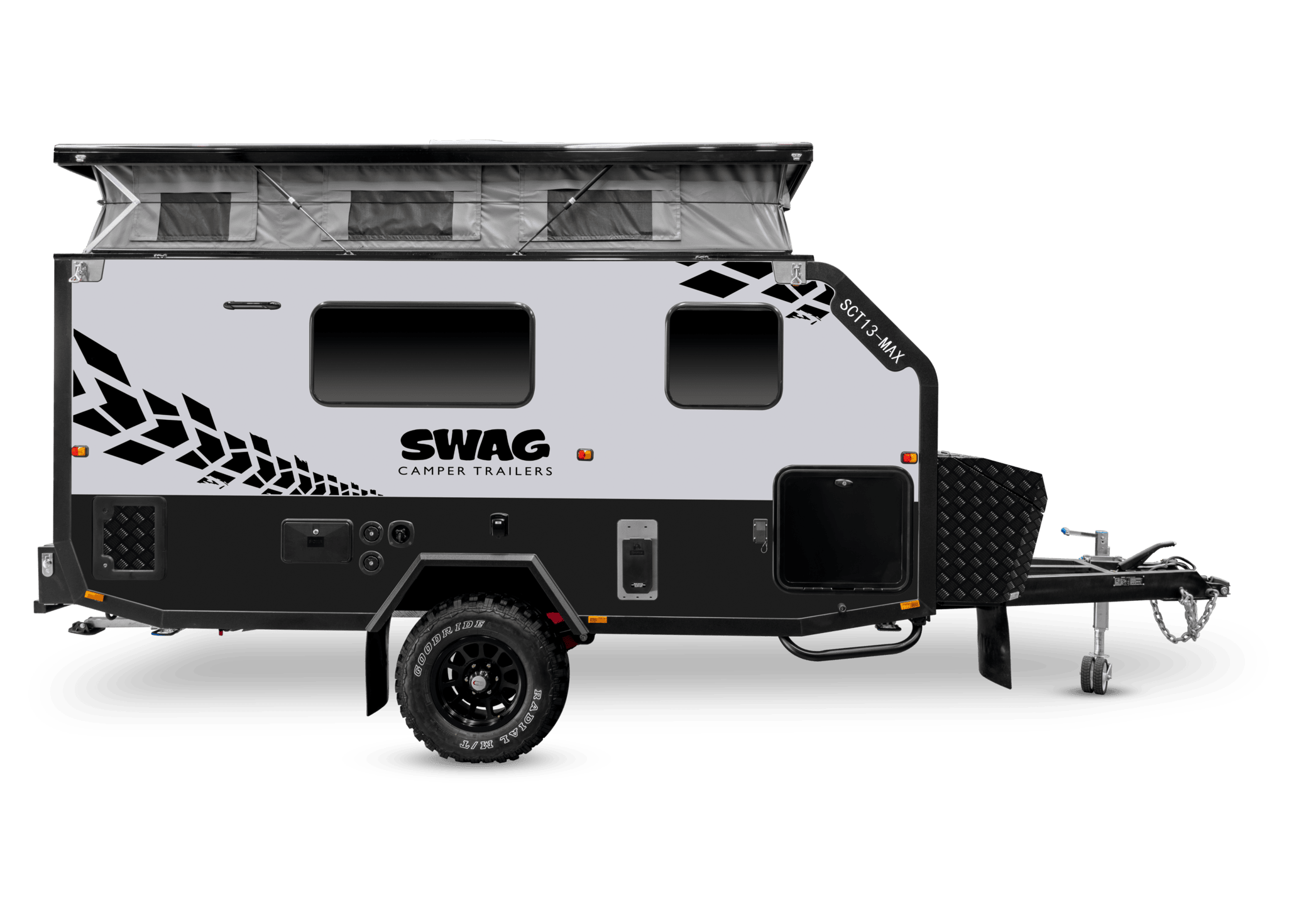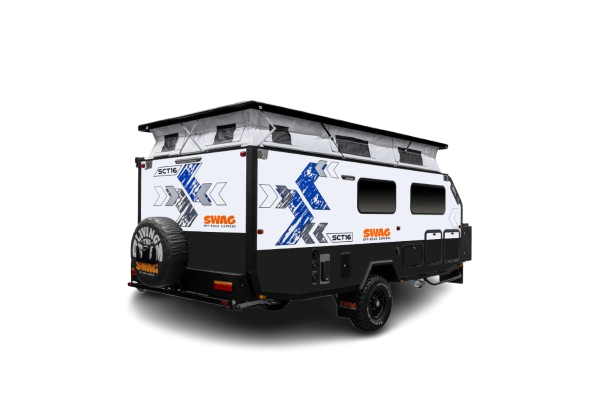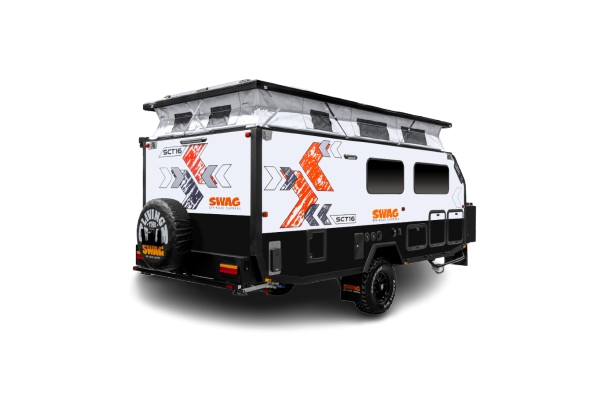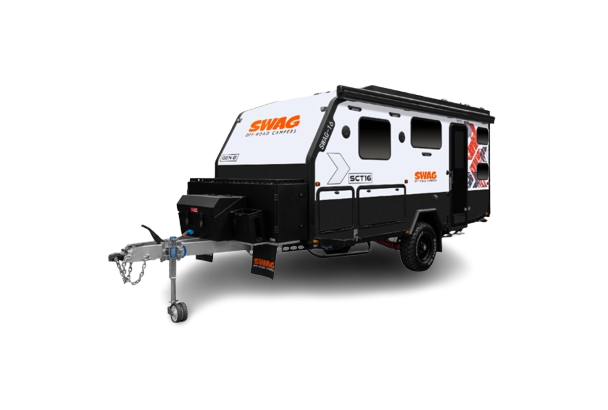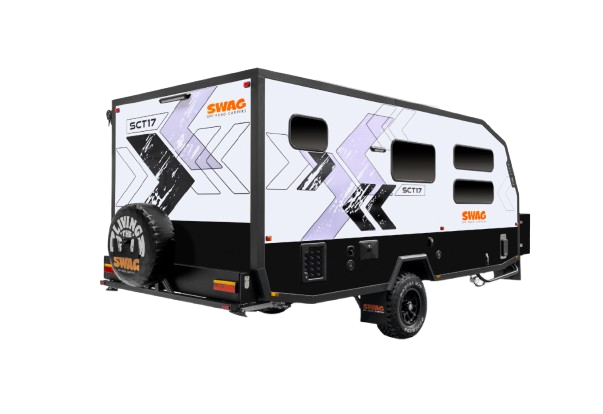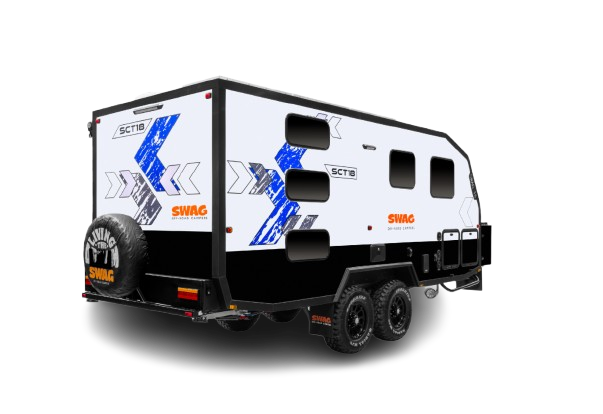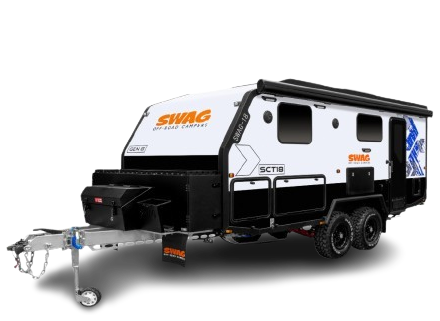Your caravan axle setup might not be the flashiest spec, but get it wrong and you’ll feel it in your fuel bill, tyre wear, and resale value.
Many buyers jump in too fast without comparing the real differences and how much it impacts their trip.
In this guide, we break down single-axle vs dual-axle caravans so you can make a smart, long-term decision.
Single-Axle vs Dual-Axle Caravan Comparison Table
| Feature | Single Axle Caravan | Dual Axle Caravan |
|---|---|---|
| Axle & Wheel Setup | One axle with two wheels | Two axles with four wheels |
| Towing Ease | Easier to tow, lighter load, suits less experienced drivers | Heavier to tow, needs a capable tow vehicle |
| Stability on the Road | Can sway more in high winds or at speed | More stable at higher speeds and in rough conditions |
| Manoeuvrability | Easier to reverse and park, especially in tight spaces | Harder to manoeuvre due to size and weight |
| Load Capacity | Lower storage capacity, best for light travel | Higher storage capacity, suits families or long trips |
| Off-Road Performance | Suitable for light off-road or sealed roads | Better suited for rough terrain and extended off-road travel |
| Fuel Efficiency | Uses less fuel due to lighter weight | Higher fuel consumption when towing |
| Maintenance | Lower cost — fewer tyres, brakes, and parts | More ongoing maintenance — double the wheels, bearings, brakes |
| Comfort and Ride | May feel bumpier on rough roads | Smoother ride thanks to better suspension and extra wheels |
| Interior Space | Generally more compact layouts | More room for beds, seating, gear, and appliances |
| Upfront Cost | More affordable entry point | More expensive to buy |
| Resale Value | Holds value for basic use or beginners | Strong resale appeal for full-time travellers or families |
| Best For | First-time buyers, couples, short trips, smaller tow vehicles | Families, experienced travellers, long-distance touring, off-road use |
| Axle & Wheel Setup | One axle with two wheels | Two axles with four wheels |
| Towing Ease | Easier to tow, lighter load, suits less experienced drivers | Heavier to tow, needs a capable tow vehicle |
| Stability on the Road | Can sway more in high winds or at speed | More stable at higher speeds and in rough conditions |
| Manoeuvrability | Easier to reverse and park, especially in tight spaces | Harder to manoeuvre due to size and weight |
| Load Capacity | Lower storage capacity, best for light travel | Higher storage capacity, suits families or long trips |
| Off-Road Performance | Suitable for light off-road or sealed roads | Better suited for rough terrain and extended off-road travel |
| Fuel Efficiency | Uses less fuel due to lighter weight | Higher fuel consumption when towing |
| Maintenance | Lower cost — fewer tyres, brakes, and parts | More ongoing maintenance — double the wheels, bearings, brakes |
| Comfort and Ride | May feel bumpier on rough roads | Smoother ride thanks to better suspension and extra wheels |
| Interior Space | Generally more compact layouts | More room for beds, seating, gear, and appliances |
| Upfront Cost | More affordable entry point | More expensive to buy |
| Resale Value | Holds value for basic use or beginners | Strong resale appeal for full-time travellers or families |
| Best For | First-time buyers, couples, short trips, smaller tow vehicles | Families, experienced travellers, long-distance touring, off-road use |
What’s the Difference Between Single and Dual-Axle Caravans?
The difference between single and dual axle caravans comes down to how many axles and wheels sit beneath the chassis.
- Single-axle caravans have one axle with two wheels.
- Dual-axle caravans have two axles with four wheels.
This simple change in structure affects how the caravan tows, how much gear it can carry, what kind of terrain it can handle, and what kind of vehicle you’ll need to tow it.
Single-axle caravans are typically lighter and easier to handle. They’re popular with solo travellers, couples, and those using mid-size 4WDs or SUVs. They’re well-suited to weekend trips, short getaways, and travelling light without overcomplicating things.
Dual-axle caravans are heavier, more stable at highway speeds, and offer better performance on unsealed or uneven roads. With more wheels on the ground and greater load capacity, they’re a favourite for growing families, off-road adventurers, and full-time travellers doing long stretches across the country.
They also tend to require a larger tow vehicle, which is something worth considering if you’re thinking of upgrading.
Pros and Cons of a Single-Axle Caravan
Single-axle caravans offer plenty of advantages for lighter travel, easier towing, and lower upfront costs. But they do come with a few trade-offs. Here’s a breakdown of the key pros and cons to help you decide if this setup suits your travel plans.
| Pros | Cons |
|---|---|
| Lighter and easier to tow — ideal for first-time caravanners | Less stable at high speeds or in crosswinds |
| Lower upfront cost — more accessible for budget-conscious buyers | Lower load capacity — limited storage for families or full-time travel |
| Easier to reverse, manoeuvre, and park in tight spaces | More pressure on two tyres — can lead to faster wear |
| Compatible with a wider range of tow vehicles (e.g. mid-size SUVs) | Not as comfortable for long-haul or rough terrain trips |
| Better fuel efficiency due to reduced towing weight | Fewer interior layout options compared to larger vans |
| Easier to move by hand when unhitched | Suspension may not be as heavy-duty for off-road adventures |
| Simpler and cheaper maintenance — fewer wheels, bearings, brakes | Less braking power than a dual axle under heavy loads |
| Great for short trips, solo travellers, or couples | Limited upgrade potential — may outgrow it if your travel needs expand |
Pros and Cons of a Dual-Axle Caravan
Dual axle caravans are built for stability, space, and longer journeys, making them a solid choice for families and off-road adventurers. Below are the main benefits and drawbacks to consider before choosing this type of setup.
| Pros | Cons |
|---|---|
| More stable when towing — especially at speed or on rough terrain | Heavier — requires a more capable tow vehicle |
| Higher load capacity — ideal for families or longer trips | More expensive upfront than single axle caravans |
| Better weight distribution improves safety and control | Higher running costs — more tyres, brakes, and parts to maintain |
| Smoother ride — absorbs bumps and uneven surfaces more effectively | Harder to park and manoeuvre in small campsites or driveways |
| More interior space for gear, kids, and creature comforts | Uses more fuel due to added weight |
| Built for off-road and full-time use — suits long-haul touring | Heavier on tyre wear if poorly loaded or not balanced |
| Redundancy — one tyre failure is less critical with four wheels | May not be compatible with smaller or medium tow vehicles |
| Better resale value for long-distance or family-oriented buyers | Can feel overwhelming for first-time owners |
Single-Axle or Dual-Axle Caravan: Which One is Right for You?
Choosing between a single-axle and dual-axle caravan comes down to how you travel, who you’re travelling with, and what you need from your setup.
A single-axle caravan is a great choice if you want something that’s easy to tow, more fuel-efficient, and simpler to handle. It’s ideal for weekend getaways, shorter trips, or anyone using a smaller tow vehicle. Couples, solo travellers, and first-time buyers often find this option easier to manage.
If you’re planning longer journeys, travelling with family, or carrying more gear, a dual axle caravan may be the better fit. These models offer more space, greater stability, and are built to handle rougher conditions. They’re well-suited to off-road adventures, full-time touring, or anyone who wants more comfort and capacity on the road.
Still weighing it up?
In the next section, we’ll look at cost factors that might help you decide which setup makes more sense for your travel plans and budget.
Cost Considerations For Single and Dual-Axle Caravans
When comparing single and dual-axle caravans, cost is more than just the upfront price. It includes what you’ll spend on towing, maintenance, and long-term use.
Single-axle caravans are usually more affordable to buy. They’re lighter, which means lower fuel use and less strain on your vehicle. With only two tyres and one axle, servicing is simpler and cheaper. These savings can make a big difference, especially for first-time buyers or families working with a set budget.
Dual-axle caravans cost more upfront. They also tend to have higher running costs. You’ll need to service more components, replace more tyres, and may spend more on fuel. On the flip side, their larger size and stronger build can give you better resale value and more years of use, especially if you travel regularly or go off-road.
If you’re planning shorter trips and want to keep ongoing costs low, a single axle model could be the more practical choice. But if you’re investing in long-term travel, especially with a family or full setup, a dual axle could offer better value over time.
Off-Road Performance: Single Axle vs Dual Axle Caravans
If you’re planning to head off the beaten track, the type of axle setup you choose will impact how your caravan handles rough terrain, gravel roads, and unsealed surfaces.
Dual-axle caravans are better suited for off-road travel. With four wheels and a stronger chassis, they offer more stability, better weight distribution, and improved traction over bumps, dips, and uneven ground. They’re also more durable for longer trips across remote areas, especially when fully loaded.
Single-axle caravans can handle light off-road conditions and sealed country roads but may struggle on more rugged tracks. They’re easier to manoeuvre and lighter to tow, which can help in tight or hilly spots, but the reduced suspension and two-wheel setup limits their durability on harsh terrain.
If you’re sticking to caravan parks or sealed roads with the occasional dirt track, a single axle model can still get the job done. But for extended off-grid travel or serious off-road adventures, a dual axle build gives you more control, safety, and peace of mind.
Looking to Buy a New Caravan for Your Next Adventure?
Whether you’re comparing weight, budget, or off-road performance, finding the right fit matters.
At SWAG Camper Trailers, we build caravans for real Aussie travel — and we’ll help you choose the one that suits your lifestyle, your vehicle, and where you want to go.
Explore our range of Single Axle Caravans and Dual Axle Caravans, or drop into a SWAG showroom to speak with someone who’s towed both and can give you straight answers.
